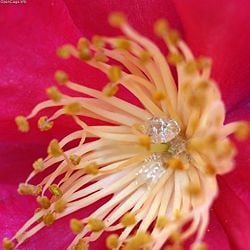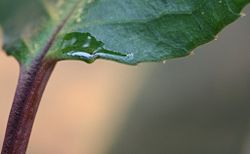Nectar
In botany, nectar is a sugar-rich liquid produced by plants. It is produced either by the flowers, in which it attracts pollinating animals or by extrafloral nectaries, which provide a nutrient source to animal mutualists providing anti-herbivore protection. It is produced in glands called nectaries.
((A sweet liquid secreted by flowers of various plants, consumed by pollinators, such as hummingbirds and insects, and gathered by bees for making honey)
Nectar is derived from Latin nectar "drink of the gods", which in turn has its origins in the Greek word νέκταρ (néktar), presumed to be a compound of the elements nek- "death" and -tar "overcoming". The earliest recorded use of its current meaning, "sweet liquid in flowers", dates back to 1609.[1]
Floral nectaries
Floral nectaries are generally located at the base of the perianth, so that pollinators are made to brush the flower's reproductive structures, the anthers and pistil, while accessing the nectar.
Extrafloral nectaries
Nectar produced outside the flower is generally made to attract predatory insects. These predatory insects will eat both the nectar and any plant-eating insects around, thus functioning as 'bodyguards'.[2] Extrafloral nectaries are generally located on the leaf petioles, mid-rib or leaf margin. They are thought to be modified trichomes and exude nectar which is sourced from phloem sap. Extrafloral nectaries can be found on species belonging to (amongst others) the genera: Salix, Prunus and Gossypium.
Nectar is economically important as it is the sugar source for honey. It is also useful in agriculture and horticulture because the adult stages of many predatory insects, as well as hummingbirds and butterflies, feed on nectar.
Nectarivore
In zoology, a nectarivore is an animal which eats the sugar-rich nectar produced by flowering plants. Most nectarivores are insects or birds, but there are also nectarivorous mammals, notably several species of bats in the Southwestern United States and Mexico, as well as the Australian Honey Possum (T. rostratus), and Geckos (genus Phesulma) in Mauritius. The term is less exclusive than other -vores; many animals that are considered nectarivorous may also be insectivorous. Many species are nectar robbers, performing no pollination services to a plant while still consuming nectar.
Nectar source
A nectar source is a flowering plant that produces nectar as part of its reproductive strategy. These plants create nectar, which attract pollinating insects and sometimes other animals such as birds.
Nectar source plants are important for beekeeping, as well as in agriculture and horticulture. Their use is particularly important for organic agriculture and organic horticulture, where they serve not only to attract pollinators for crops, but also provide habitat for beneficial insects and other animals that provide pest control.
In gardens, nectar sources are often provided to attract butterflies and hummingbirds as well.
Nectar sources for honey bees
While many plants produce nectar, beekeepers prefer to place their hives near certain plants, rather than others, for the qualities of the honey produced. Certain agricultural crops, such as clover and buckwheat, are used to make specific honeys.
Some plants are avoided by beekeepers due to toxins found in the nectar. For example, honey made from the nectar of Rhododendrons ("mad honey") contains neurotoxic chemicals.
See also: Northern Nectar Sources for Honey Bees
Nectar sources for pollinators
Pollinating insects, including honey bees and many other insects, are a necessary element when growing most crops (though cereal grain crops are wind-pollinated). By maintaining a constant supply of nectar in areas adjacent to a field or vegetable garden throughout the growing season, farmers and gardeners ensure that their crops can be pollinated when they flower.
Nectar sources for beneficial insects
Particularly organic horticulture and organic farming, nectar sources are maintained to attract and maintain a population of beneficial insects. Insects such as predatory wasps, hoverflies and lacewings feed on nectar as adults, while their larval forms are predatory and feed on garden pests.
Nectar sources for butterflies and hummingbirds
In gardens, the presence of butterflies and hummingbirds is often encouraged. Butterflies are attracted by most good nectar sources, though there are particular plants they seem to prefer. Certain plants are also grown as a food source for their caterpillars.
Hummingbirds feed on tubular flowers, using their long, siphoning beaks. Many plants in the mint family, Lamiaceae, are used to attract hummingbirds.
Nectar guide
Nectar guides are patterns seen in some flowers that guide pollinators to the nectar and pollen.
These patterns are sometimes visible to humans; for instance, the Dalmatian toadflax (Linaria genistifolia) has yellow flowers with orange nectar guides.[3] However, in some plants, such as sunflowers, they are visible only under ultraviolet light. Under ultraviolet, the flowers have a darker center, where the nectaries are located, and often specific patterns upon the petals as well. This is believed to make the flowers more attractive to pollinators such as honey bees and other insects that can see ultraviolet. This page on butterflies shows an animated comparison of black-eyed Susan (Rudbeckia hirta) flowers in visible and UV light.
The ultraviolet color, invisible to humans, has been referred to as bee violet, and mixtures of ultraviolet with shorter (yellow) wavelengths are called bee purple by analogy with purple in human vision..[4]
Give examples of Orchids!
ReferencesISBN links support NWE through referral fees
- ↑ Douglas Harper. Online Etymology Dictionary. Retrieved on 2007-09-26.
- ↑ Plant-Provided Food for Carnivorous Insects - Cambridge University Press
- ↑ dead link?.
- ↑ Charles D. Michener (1974). The Social Behavior of the Bees: A Comparative Study. Harvard University Press. ISBN 0674811755.
External links
- Dalmatian Toadflax from the Southwest Exotic Plant Information Clearinghouse
- What do butterflies see? (speculation)
Template:Botany-stub
References
Credits
New World Encyclopedia writers and editors rewrote and completed the Wikipedia article in accordance with New World Encyclopedia standards. This article abides by terms of the Creative Commons CC-by-sa 3.0 License (CC-by-sa), which may be used and disseminated with proper attribution. Credit is due under the terms of this license that can reference both the New World Encyclopedia contributors and the selfless volunteer contributors of the Wikimedia Foundation. To cite this article click here for a list of acceptable citing formats.The history of earlier contributions by wikipedians is accessible to researchers here:
The history of this article since it was imported to New World Encyclopedia:
Note: Some restrictions may apply to use of individual images which are separately licensed.


